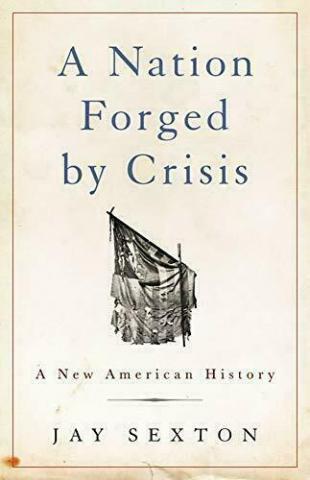Jay Sexton: A Historian of Crisis Looks at the Present Moment
Jay Sexton: A Historian of Crisis Looks at the Present Moment
One of the objectives I had when I wrote a recent book on crises in American history was to reassure readers that the United States was not then in the midst of a nation-defining crisis, at least not by historical standards. “Cracks have emerged in the pillars of American capitalism and constitutional democracy, but so far, they have remained standing,” I wrote. “It has been possible merely to rearrange the deck chairs of the ship of state, rather than overhauling the aging engines that are sputtering in the boiler room below deck.”
Those lines were published less than two years ago, which already feels like a lifetime ago. COVID-19 has touched so many aspects of our global order, and with such ferocious speed, that it begs a question: how does our current predicament stack up to those crises of the past?
I use three benchmarks to determine what constitutes a major crisis. The first is that it spreads uncontrollably throughout a society. Existing political processes cannot contain the contagion. Observers in the past often equated crisis to health scares for good reason: like an infectious disease, an ailment in one sector of public life quickly spread to others, poisoning the whole body politic.
The classic example of such a metastasizing crisis began with the Wall Street collapse of 1929. The sudden malady on the financial markets soon infected the broader economy. The ensuing banking collapse of 1932-33 increased unemployment to its destabilizing peak of 25%. Thereafter, the contagion roared beyond the economy: social conflict escalated, politics entered an unprecedented period of flux and transformation, and international competition triggered world war.
The second feature of major crisis concerns the collective response it precipitates. Confronting a mushrooming crisis necessitates the rapid mobilization of power, a wrenching process of political transformation that brings about lasting and often unexpected change.
Think here of the Union war effort during the Civil War. The imperative of arming and equipping a million-man army almost out of thin air forever changed the United States. War mobilization transformed the powers of the federal government, destroyed slavery, accelerated industrialization, gave birth to a new financial system centered in Wall Street, and – not to be forgotten – flipped the social politics of immigration in favor of open borders.
These changes were not the inevitable progression of America’s founding creeds; rather, they were the contingent and abrupt results of the mobilization of immense power required to contain the crisis brought on by the slaveholder rebellion. It is in rare moments like this that sudden and unanticipated change sweeps across the landscape. In March, 1861, President Lincoln signaled that he was open to signing a constitutional amendment that forever forbade the federal government from abolishing slavery within the states where it existed. Two years later armed African Americans in blue coats were marching through the heart of the cotton kingdom, reducing the Old South to smoldering rubble.
Back to the pre-COVID-19 twenty-first century. Using these benchmarks, the crises of our time – most notably 9/11 and the 2007/8 financial collapse – were clearly not on the scale as those most transformative ones of the past.
The shocks of 9/11 and 2007/8 were relatively well contained to their respective realms of national security and political economy. Meeting their costs did not require transformative change. After 9/11, Americans were told to go shopping so that business could carry on as usual. The stimulus legislation after 2008 was paid for by low-interest borrowing that required few immediate sacrifices – indeed, tax cuts remained the keystone of the political economy even as the budget deficit ballooned. Those costs that weren’t kicked down the road were outsourced to those with the least political power (service-members of our volunteer military and low-wage earners).
What we have with COVID-19 looks to be on a different scale. Though it remains early days, and the prospect of a crisis-resolving vaccine gives cause for hope, there is no question that the crisis is spreading and intensifying by the day. What began as a public health disaster across the Pacific has snowballed into a global economic collapse that is approaching 1930s territory. Confronting this contagion will require sacrifices from all. Power will need to be mobilized in new ways. Transformative change becomes more likely by the day.
What is more is that COVID-19 is destabilizing all nations. Here we arrive at the third characteristic of a transformative crisis: its course and consequences spill beyond national borders, in the process reshaping the international landscape itself.
Those past crises that forged the American nation were all international in nature. The Revolution was a by-product of recurrent Anglo-French warfare and part of the age of Atlantic revolutions; the Civil War was but one instance of violent nation-making and emancipation that occurred across the world in the mid-nineteenth century; and the New Deal was America’s response to a catastrophe that elsewhere empowered fascists and communists, thus setting the stage for the global showdown of the 1940s.
The United States came out the other end of each of these past crises having enhanced its international position, boasting new structures of national power that were custom-designed for the geopolitical order that lay ahead. One of the most alarming aspects of our current crisis is that all signs currently point in a different direction: to an America that emerges from this pandemic, whenever that may be, with less power, influence, and prestige on the global stage. In this regard, our sputtering ship of state appears to be entering uncharted waters.
Jay Sexton is Professor of History and Kinder Institute Chair of Constitutional Democracy. His most recent book is entitled A Nation Forged by Crisis: A New American History (Basic Books, 2018) argues that international forces have shaped the course of U.S. history during its greatest moments of transformative change.
